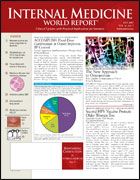Publication
Article
Internal Medicine World Report
Malaria on the Rise: CDC Issues New Treatment Guidelines
Author(s):
By David S. MacDougall
JAMA
The increasing numbers of US residents who travel or work abroad are contributing to a rising incidence of malaria in this country, highlighting the need for improved diagnosis and treatment. The Centers for Disease Control and Prevention (CDC) has now issued new, evidence-based recommendations for the management of malaria in the United States (. 2007;297:2264-2277) in an effort to help physicians better deal with this new medical reality.
Plasmodium falciparum
Because infection with , the most common cause of malaria in the United States, can progress rapidly to severe illness or to death within 2 days, the guidelines recommend immediate treatment of all patients with this type of malaria.
P falciparum
MMWR Surveill Summ
In 2005, was responsible for nearly half of the 1528 malaria cases reported in the United States. Of these, 7 fatalities occurred, which represents an increase of 15% from the 1324 cases reported in 2004 (. 2007;56:23-38).
The rise in malaria cases is attributed primarily to increasing travel to endemic areas, such as Asia, the Middle East, and the Americas, as well as to more complete reporting.
"Malaria is the most common cause of fever in a returned traveler," said coauthor Monica Parise, MD, of the Parasitic Diseases Branch at the CDC. "Clinicians need to remember to take a travel history and [know] when they should look for malaria."
Common manifestations include back pain, chills, cough, diarrhea, fever, headache, increased sweating, myalgia, nausea, and vomiting.
P falciparum
Plasmodium
Any patient who has been in an endemic area in the year preceding the onset of disease manifestations should be evaluated for malaria. Most patients who have acquired malaria in other countries demonstrate signs and symptoms within the first 3 months of arrival in the United States, although with some strains, the primary attack is delayed for up to 18 months after being bitten by an infected mosquito.
P falciparum
Figure. The trophozoites of have a ring form, with double chromatin dots.
Evidence of malaria parasites on Giemsa-stained thick and thin blood films confirms the diagnosis (Figure). Polymerase chain reaction and rapid immunochromatographic assays are reliable alternative diagnostic tools, but these are not readily available.
The initial treatment of malaria should be based on the 5 following variables:
- Infecting species
- Density of parasitemia
- Drug-resistance pattern where the infection was acquired
- Patient's ability to tolerate oral medication
- Signs of severe malaria.
The need for patient hospitalization has been controversial. The guidelines recommend that infected patients be initially admitted to monitor and verify treatment efficacy.
P falciparum
Chloroquine (Aralen Phosphate) remains the treatment of choice for malaria acquired in Mexico, Hispaniola, Central America west of the Panama Canal, the Middle East, and parts of China.
P falciparum
For acquired in all other malaria-endemic countries, the 3 treatment options are:
- Oral quinine plus tetracycline (Sumycin), doxycycline (Vibramycin), or clindamycin (Cleocin)
- Atovaquone-proguanil (Malarone)
- Mefloquine (Lariam).
The combination of sulfadoxinepyrimethamine is no longer recommended because of increasing resistance.
Plasmodium vivax
P vivax
Atovaquone-proguanil is the recommended first-line treatment for malaria acquired in areas with chloroquine-resistant . Alternative treatments include quinine plus doxycycline or tetracycline, and mefloquine.
Quinidine gluconate, the only parenteral antimalarial drug available in the United States, is recommended for the treatment of severe malaria. And although artemisinin derivatives are a key component of malaria treatment worldwide, these are not yet approved in this country.
IMWR
"We need a parenteral artemisinin derivative to be available in the United States, since studies so far have shown improved survival in severe malaria with this class of drugs as opposed to other drugs," Dr Parise told .





